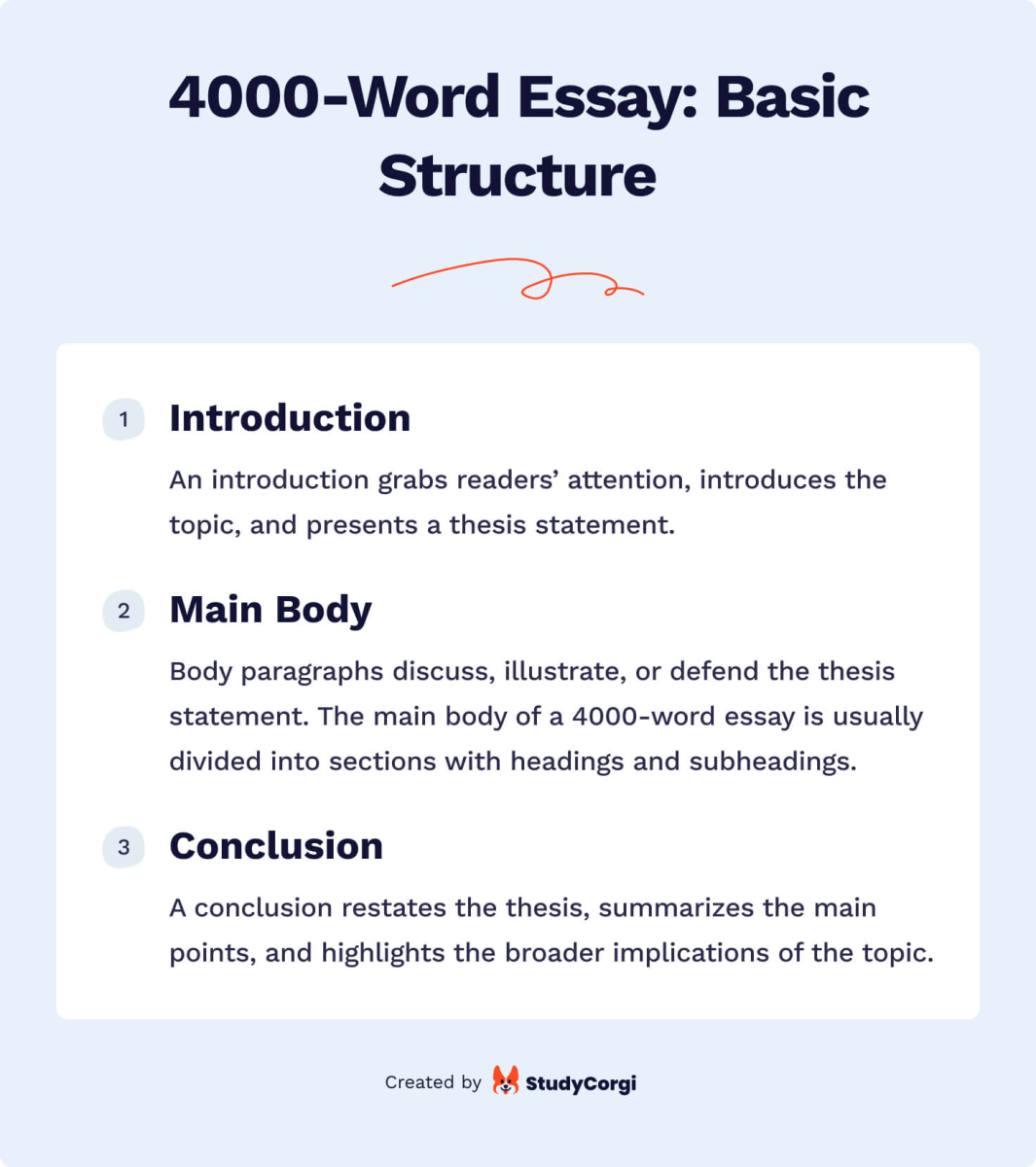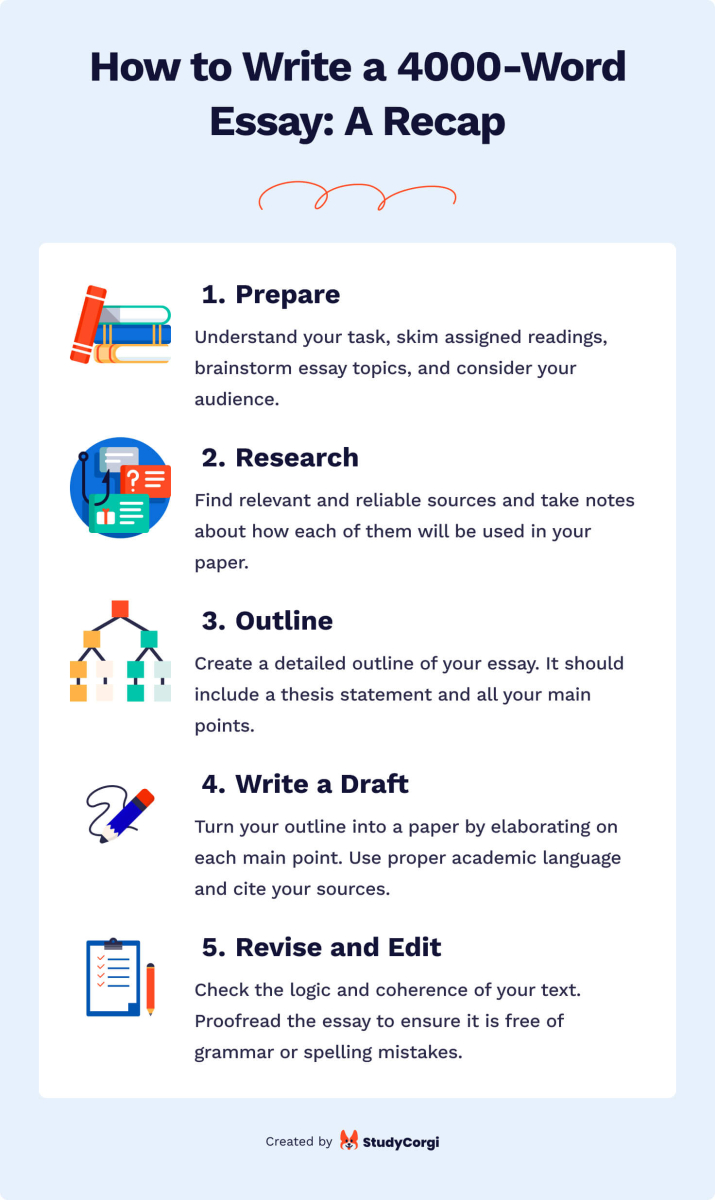How to write a 4000-word essay? Many students ask this question. 4000-word essay structure and argumentation are much more complex than those of shorter assignments. Developing a workable yet comprehensive thesis statement for papers of such a length is also challenging. So, students immediately get overwhelmed and stuck even before starting the work process.
The trick to composing a coherent and informative essay of this size is to divide it into parts and treat each as a separate, independent task. In this article, we’ll discuss how long it takes to write a 4000-word essay with and without research, how many references it should contain, and how to structure the assignment.
Read on to learn more about 4000-word essay writing!
📑 How Many Pages Is a 4000-word Essay?
As a rule, one double-spaced page contains an average of 275 words, so a 4000-words double-spaced essay should be 14.5 pages long. A single-spaced page includes 550 words on average, meaning 4000 words will fit into approximately 7 single-spaced pages. However, your paper’s length may vary depending on your choice of font, spacing, margins, and the number of headings and subheadings in your article.
We’ve checked how much space 4000 words will take with the most common font and page layout characteristics: 12-point Times New Roman font and 1-inch margins on all sides. With these parameters, a 4000-word essay takes 13 full double-spaced or 7 single-spaced pages.
How Long Does It Take to Write a 4000-Word Essay?
Writing a 4000-word essay takes a lot of time. Simply typing 4000 words will take about 2 hours, with an average typing speed of 40 words per minute. However, besides typing, you will have to spend much time researching, outlining, revising, and proofreading your work. As a rule, students spend at least 2 days writing a 4000-word article.
🧩 4000 Word Essay: Structure
A 4000 words essay is a long paper, so you should make a detailed outline before writing it. Consider the headings your 4000-word paper will include, what sources you will use in each part, and which thought will guide each section. Below we will give a general structure of a 4000-word essay, which will suit you regardless of whether you’re writing an argumentative, persuasive, or research paper.

Introduction
Every essay must start with an introduction, which aims to grab the readers’ attention, inform them of the theme of the paper, and give a thesis statement. The opening paragraph has 4 main elements:
- Hook. The hook is the first line of the essay that piques readers’ interest and encourages them to continue reading. You can achieve this by offering a catchy quote, a surprising statistic, or a rhetorical question.
- Background and purpose. The subsequent section provides background information about your topic. This part also helps readers understand why you are writing about this issue.
- Thesis statement. It is a sentence clearly stating the essay’s central argument and the critical supporting points.
- Road map. It is a preview statement that explains how your paper is organized.
In shorter essays, an introduction usually takes one paragraph, but a 4000-word paper may need 2 or more paragraphs to properly introduce the topic.
Essay of 4000 Words: Paragraph Writing
A well-written body paragraph discusses, illustrates, and defends your essay’s thesis statement. Here’s how to create one:
- Start with a topic sentence. Your topic sentences should connect to your thesis to strengthen your essay’s coherence. When writing a topic sentence, consider what your paragraph is about. Why did you choose to include the given information? Why is this paragraph significant to your thesis? What argument are you attempting to make?
- Explain your topic sentence. If your topic sentence needs further explanation, add a sentence or two to elaborate on it.
- Introduce your evidence. You can smoothly integrate quotes or statistics to support the claim in your topic sentence. Remember to cite your sources correctly when using research findings or ideas from someone else’s works.
- Explain your evidence. Each piece of external evidence should come with a sufficient interpretation, showing the relevance of this data to your broader thesis statement and arguments.
- Add a concluding sentence. End a paragraph with a concluding statement that summarizes your idea and links this point to the next one.
Remember to include linking words and transition sentences within and between body paragraphs to ensure a smooth flow of thoughts.
Conclusion
A conclusion is your opportunity to synthesize your thoughts and illustrate the importance of your ideas. It’s also your chance to make a final impression and close your article positively. Here are a few things you should and shouldn’t do when writing your last paragraph.
Do:
- Respond to the “So what?” question to explain why readers should care about your topic.
- Return to the scenario or theme in your introduction.
- Synthesize your arguments to show how your opinions and evidence fit together.
- Propose a solution to the issues raised in the essay.
- Highlight the broader implications of the points raised in your essay.
Don’t:
- Start with a cliché like “in conclusion” or “in summary.” They work in speeches but sound corny in writing.
- Introduce your thesis in the conclusion for the first time.
- Add new ideas or evidence to your conclusion.
- Repeat the thesis without changing it.
- Make emotional appeals that don’t fit the overall style of your academic paper.
Other Possible Elements
Unlike shorter essays, 4000-word articles require a more in-depth study of the topic. So, they can contain visuals, tables, charts, calculations, and additional components such as abstracts, appendices, and tables of content. Let’s look at the elements that make this essay unique.
Abstract
An abstract is a brief (150-250 words) standalone summary of a larger work. This component is essential for published academic papers. It helps researchers find a publication in a database. Moreover, scholars often scan abstracts to decide whether the article is relevant to their area of interest.
The elements of an abstract can vary depending on the field of study. However, a standard abstract will contain an article’s purpose, problem, methodology, results, and implications.
Executive Summary
An executive summary is a review of the critical points of a research report. It is common in writing assignments for business students who often prepare business reports for organizations.
Executive summaries take 10% of the paper’s total word count. So, in a 4000-word report, it should be about 400 words. Here’s how you create one:
- Read the report and identify its goal, main points, and critical suggestions.
- Begin your executive summary with an opening statement and brief background.
- Introduce the report’s purpose and methods of data collection and analysis.
- Describe the main findings and major recommendations with justifications.
- Structure your summary: add headings and ensure each paragraph covers one main point.
Table of Contents
A table of contents (TOC) is a list of your document’s headings and subheadings with page numbers. It follows the abstract or executive summary.
MS Word can create a TOC automatically if you correctly label your headings and subheadings. To apply styles to your headings, go to “Home” in your Word document and choose a suitable option from the “Styles” gallery. This way, you can format various section and subsection titles of your essay as Level-1 to Level-5 headings.
References
At the end of the essay, you should give a list of cited literature. Its formatting will depend on the chosen referencing style. For instance, the APA and MLA styles list sources in alphabetic order, but the Vancouver citation style arranges them as they appear in the text. To get help with citing your sources, use our citation machine.
Appendices
An appendix provides additional information that helps explain the research problem but is too extensive to be included in the main body. For example, supplementary tables, charts, diagrams, photographs, and calculations usually go to appendices. Each distinct topic or data set should have its appendix with a descriptive heading.
When deciding what to include in an appendix, remember that the information in appendices is non-essential and can be omitted without affecting your essay’s meaning, credibility, or conclusions. Moreover, you should number appendix tables and figures separately from the main paper and always refer to your appendices in the body paragraphs.
✍️ How to Write a 4000-Word Essay
Essay writing begins with thorough planning. It will help you logically organize your work. You must research and critically evaluate the material on your topic to formulate and express an argument. Follow the instructions below to excel in your writing.
Step 1: Prepare
First of all, you should thoroughly understand the task at hand by reading the assignment instructions closely. If necessary, consult your professor for clarification. If you’ve received a list of assigned readings for the essay, skim them, keeping your writing instructions in mind.
Once you understand the task and get familiar with class readings, brainstorm topics for your paper. You should also consider your audience before writing to choose the appropriate tone, language, and arguments.
Step 2: Research
Find sources that support the main argument you plan to make. Always take notes as you conduct your research. For example, you can copy and paste one main sentence from each source into a Google Docs or Microsoft Word document to convey its central point. Then, summarize what you read in your own words.
Step 3: Plan and Outline
Outlining involves planning the content of each essay paragraph, the order of sections, and the overall flow of thoughts in the essay. An outline serves as a map of the paper: it gives an idea of what your essay will look like while leaving room for modifying ideas quickly. Your essay plan should include your thesis statement, the key point of each paragraph, and evidence from sources you will use to support your argument.
Step 4: Write Your Draft
A draft is a complete first version of your 4000-words essay. With a detailed outline, writing a long paper is a manageable task. Just take the main points from your essay plan and elaborate on them in your paragraphs, supporting your claims with evidence and explanations. Begin by writing the parts that come easily to you, one paragraph or section at a time.
Step 5: Revise and Edit
Revision allows you to assess your paper regarding your topic, arguments, and audience. When revising, you ensure your essay covers the issue in the most effective way. For example, you can add, remove, or reorganize paragraphs to make your argument more compelling.
Editing involves checking for grammatical, spelling, and lexical errors and awkward sentences that make your writing hard to understand. You should edit your work to ensure your essay looks clear and professional.

📝 4000 Word Essay Example
Check out a 4000-word essay example on diabetes: The Impact of Nutrition on the Development of Type 2 Diabetes Mellitus. Below, we will review its elements to help you understand how to structure your 4000-word paper.
- Title. The essay title is “Impact of Nutrition on the Development of Type 2 Diabetes Mellitus,” which is simple, concise, and informative.
- Abstract. The abstract summarizes the paper by mentioning its objective, the main findings, and a conclusion.
- Introduction. The introduction includes all the essential elements:
- Hook: A statistical fact about diabetes.
- Background: The health effects of diabetes.
- Thesis statement: The paper argues, “Despite scientific studies citing a lack of physical exercise and obesity as the two major causes of T2DM, there is compelling evidence that nutrition has a significant role in the rise or control of the condition.” From this thesis, we understand that the essay will prove the significance of nutrition in diabetes.
- The main body is logically organized and has a clear structure thanks to the use of section headings:
- Link Between Nutrition and T2DM: This section explains the role of nutrition in diabetes.
- Nutritional Knowledge: Here, the author addresses the issue of people’s lack of awareness of diet’s role in diabetes.
- Application: This section explains why and how nutritional knowledge can be applied to the current diabetes epidemic.
- Approaches/Treatments: The writer reviews dietary approaches to diabetes management.
- Expected Outcomes/Recommendations: Based on the reviewed information, the author gives recommendations for treating diabetes patients, justifying them with expected positive outcomes.
- Conclusion. The author concludes by highlighting the link between nutrition and diabetes mellitus, summarizing the key points supporting this relationship.
- Works Cited. The essay ends with a list of references used to back up the argument. They are formatted in alphabetical order in the MLA style.
📚 4000 Words Essay Topics
Here are a few 4000-word essay topic ideas for you to explore:
- Increased Internet addiction rates during the COVID-10 pandemic.
- The metaverse and the future prospects of advertising.
- Cost-benefit analysis of prison privatization.
- Causes of irrational use of antibiotics in the US.
- Atheism in 18th-century literature.
- Ethical and legal issues of international surrogacy.
- Microbiological hazards of raw diets for cats.
- Celebrity suicides: The impact on global suicide rates.
- Internet censorship: A cross-country comparison.
- Child custody disputes: Court decisions regarding abusive parents.
